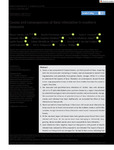Causes and consequences of liana infestation in southern Amazonia
| dc.contributor.author | Reis, SM | |
| dc.contributor.author | Marimon, BS | |
| dc.contributor.author | Morandi, PS | |
| dc.contributor.author | Elias, F | |
| dc.contributor.author | Esquivel‐Muelbert, A | |
| dc.contributor.author | Marimon Junior, BH | |
| dc.contributor.author | Fauset, S | |
| dc.contributor.author | Oliveira, EA | |
| dc.contributor.author | Heijden, GMF | |
| dc.contributor.author | Galbraith, D | |
| dc.contributor.author | Feldpausch, TR | |
| dc.contributor.author | Phillips, OL | |
| dc.date.accessioned | 2021-09-20T10:48:50Z | |
| dc.date.available | 2021-09-20T10:48:50Z | |
| dc.date.issued | 2020-11 | |
| dc.identifier.issn | 0022-0477 | |
| dc.identifier.issn | 1365-2745 | |
| dc.identifier.uri | http://hdl.handle.net/10026.1/17846 | |
| dc.description.abstract |
<jats:title>Abstract</jats:title><jats:p> <jats:list> <jats:list-item><jats:p>Lianas, a key component of tropical forests, can limit growth of trees, impacting both the structure and functioning of forests, and are expected to benefit from fragmentation and potentially from global climatic changes. While it is critical to understand the impacts of liana infestation on contemporary tropical forests across large geographical areas, to date most liana studies have been focussed on single or few sites.</jats:p></jats:list-item> <jats:list-item><jats:p>We measured and quantified liana infestation of 16,066 trees with diameter ≥10 cm in 27 plots distributed across southern Amazonia, a region characterized by substantial ecological and environmental variation and environmental change. We examined the influence of potential drivers of liana infestation at the plot, species and individual tree level. Additionally, we evaluated the effect of liana infestation on tree growth.</jats:p></jats:list-item> <jats:list-item><jats:p>More than half of all trees had lianas in their crown. At the plot level, infestation by lianas was driven by forest structure but not by the studied climate or soil fertility variables, though low levels of liana infestation were found in seasonally flooded forests.</jats:p></jats:list-item> <jats:list-item><jats:p>At the tree level, larger and stouter trees had a greater proportion of their crown infested with lianas. At the species level, trees belonging to intrinsically slow‐growing, dense‐wooded species were more susceptible to liana infestation.</jats:p></jats:list-item> <jats:list-item><jats:p>Liana infestation had a negative impact on tree growth, with growth of heavily infested trees reduced by 33% compared to non‐infested. The impact of liana infestation on tree growth was strongest for the best‐lit tree crowns, indicating that lianas act to reduce the large competitive advantage that well‐lit trees otherwise hold over their neighbours.</jats:p></jats:list-item> <jats:list-item><jats:p><jats:italic>Synthesis</jats:italic>. Lianas are a pervasive and influential feature of the extensive forests at the southern edge of Amazonia. The degree of liana infestation in forests was closely linked to species‐level variables such as potential growth and wood density as well as the size of the individual tree. The growth of heavily infested trees was particularly restricted by lianas, and especially so for trees growing in otherwise favourable conditions, indicating the potential for lianas not only to reduce forest growth rates overall, but also to modify competitive hierarchies among trees within tropical forests.</jats:p></jats:list-item> </jats:list> </jats:p> | |
| dc.format.extent | 2184-2197 | |
| dc.language | en | |
| dc.language.iso | en | |
| dc.publisher | Wiley | |
| dc.subject | biomass | |
| dc.subject | climate change | |
| dc.subject | forest structure | |
| dc.subject | habitat fragmentation | |
| dc.subject | soil | |
| dc.subject | tree mortality | |
| dc.subject | wood density | |
| dc.title | Causes and consequences of liana infestation in southern Amazonia | |
| dc.type | journal-article | |
| dc.type | Journal Article | |
| plymouth.author-url | https://www.webofscience.com/api/gateway?GWVersion=2&SrcApp=PARTNER_APP&SrcAuth=LinksAMR&KeyUT=WOS:000562951700001&DestLinkType=FullRecord&DestApp=ALL_WOS&UsrCustomerID=11bb513d99f797142bcfeffcc58ea008 | |
| plymouth.issue | 6 | |
| plymouth.volume | 108 | |
| plymouth.publication-status | Published | |
| plymouth.journal | Journal of Ecology | |
| dc.identifier.doi | 10.1111/1365-2745.13470 | |
| plymouth.organisational-group | /Plymouth | |
| plymouth.organisational-group | /Plymouth/Faculty of Science and Engineering | |
| plymouth.organisational-group | /Plymouth/Faculty of Science and Engineering/School of Geography, Earth and Environmental Sciences | |
| plymouth.organisational-group | /Plymouth/REF 2021 Researchers by UoA | |
| plymouth.organisational-group | /Plymouth/REF 2021 Researchers by UoA/UoA06 Agriculture, Veterinary and Food Science | |
| plymouth.organisational-group | /Plymouth/Users by role | |
| plymouth.organisational-group | /Plymouth/Users by role/Academics | |
| dcterms.dateAccepted | 2020-06-12 | |
| dc.rights.embargodate | 2021-9-21 | |
| dc.identifier.eissn | 1365-2745 | |
| dc.rights.embargoperiod | Not known | |
| rioxxterms.versionofrecord | 10.1111/1365-2745.13470 | |
| rioxxterms.licenseref.uri | http://www.rioxx.net/licenses/all-rights-reserved | |
| rioxxterms.licenseref.startdate | 2020-11 | |
| rioxxterms.type | Journal Article/Review |


